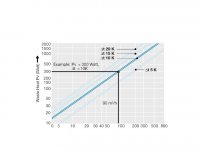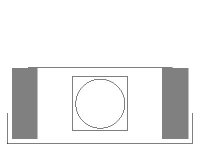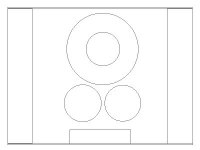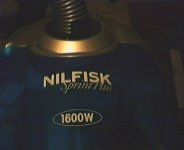Thanks Macka for the reply.
I live in Singapore where temperatures can reach quite high during the "summer" months. Due to my frequent obsession with testing my alephs, I left the top cover open & think will continue to do so at least during power on. I find the amps get hot enough even without the top cover. Good thing is my base plate where I mount the psu is pretty detached from the heatsinks and maintains a comfortable temperature. As I believe now the rectifier is even cooler than the base plate it is mounted to. I have always aimed for the most conservative ratings and spending money in the right places right at the begining though in real life its really a different story......
The point you brought up about transformer insulation temperature is quite good, I would never have thought about it. For myself I would go for a simple psu, at most a CRC filter with probably with 2*16vac transformer. At this point I would also like to ask anyone if it's even possible to convert my existing psu (2*45vdc@500va) into a 2*22vdc (500va of course)?? I read about it somewhere with some rectifier arrangement its possible to get a virtual ground?? Please help us save buying a new transformer
Though I've been resistant to fans all along, given the technology has improved to give silent PCs and PSUs, I may just consider adding one in future!
Lastly, for an idea how my amp looks like, you can see it here:
http://www.diyaudio.com/forums/showthread.php?s=&threadid=15431
I live in Singapore where temperatures can reach quite high during the "summer" months. Due to my frequent obsession with testing my alephs, I left the top cover open & think will continue to do so at least during power on. I find the amps get hot enough even without the top cover. Good thing is my base plate where I mount the psu is pretty detached from the heatsinks and maintains a comfortable temperature. As I believe now the rectifier is even cooler than the base plate it is mounted to. I have always aimed for the most conservative ratings and spending money in the right places right at the begining though in real life its really a different story......
The point you brought up about transformer insulation temperature is quite good, I would never have thought about it. For myself I would go for a simple psu, at most a CRC filter with probably with 2*16vac transformer. At this point I would also like to ask anyone if it's even possible to convert my existing psu (2*45vdc@500va) into a 2*22vdc (500va of course)?? I read about it somewhere with some rectifier arrangement its possible to get a virtual ground?? Please help us save buying a new transformer
Though I've been resistant to fans all along, given the technology has improved to give silent PCs and PSUs, I may just consider adding one in future!
Lastly, for an idea how my amp looks like, you can see it here:
http://www.diyaudio.com/forums/showthread.php?s=&threadid=15431
Kenny,
Cool.....
I love your amp, gorgous build quality......I'm impressed!!
Not sure about the conversion...alas I have same problemo....boat anchor..
Try this address for good, cheap tranformers,
http://www.users.bigpond.com/harbuch/harbuch/default.htm
regards
macka
Cool.....
I love your amp, gorgous build quality......I'm impressed!!
Not sure about the conversion...alas I have same problemo....boat anchor..
Try this address for good, cheap tranformers,
http://www.users.bigpond.com/harbuch/harbuch/default.htm
regards
macka
For those interested in solving their heat issue with fans, here is a handy diagram for determing the air flow for which the selected fan is required to generate.
This is determined by the dissipated heat within the enclosure from the heat source (ie the power supply transformers, rectifiers, chokes etc, and source resisters) and the permissible rise (∆T) of the cooling air flow(from entry to exit of the device
to be cooled).
The maximum allowable ∆Tdepends on the temperature sensitivity of the individual components within the amplifier enclosure, ie transformers, capacitors , so plan accordingly.
Check the ratings of the components and remember to use the nominal ambient temperature in the room in which you have the X Aleph/Aleph as your reference point for calculating the maximum allowable temperature.
For T = 5 K means e.g. that the average air flow leaving the device to be cooled may only be 5°C warmer than the ambient temperature (a large volume of air is required for this purpose). So use a larger fan ie 90-127mm.( if you live on the Equator or in the tropics)
A lower air flow rate is sufficient if a higher temperature difference
(e.g. T = 20 K), can be tolerated. ie a smaller fan can be used. ie 60-80mm (if you live in the North pole/Canada)
One final point. The optimum operating range of the required fan, however, must alsobe able to deliver a suitable static pressure ∆pf, in order to force the cooling air through the appliance.
A fan must therefore, be selected that provides the required air flow performance within its optimum operating range (use the performance curves from the fan manufacturer.)
Good luck
macka
This is determined by the dissipated heat within the enclosure from the heat source (ie the power supply transformers, rectifiers, chokes etc, and source resisters) and the permissible rise (∆T) of the cooling air flow(from entry to exit of the device
to be cooled).
The maximum allowable ∆Tdepends on the temperature sensitivity of the individual components within the amplifier enclosure, ie transformers, capacitors , so plan accordingly.
Check the ratings of the components and remember to use the nominal ambient temperature in the room in which you have the X Aleph/Aleph as your reference point for calculating the maximum allowable temperature.
For T = 5 K means e.g. that the average air flow leaving the device to be cooled may only be 5°C warmer than the ambient temperature (a large volume of air is required for this purpose). So use a larger fan ie 90-127mm.( if you live on the Equator or in the tropics)
A lower air flow rate is sufficient if a higher temperature difference
(e.g. T = 20 K), can be tolerated. ie a smaller fan can be used. ie 60-80mm (if you live in the North pole/Canada)
One final point. The optimum operating range of the required fan, however, must alsobe able to deliver a suitable static pressure ∆pf, in order to force the cooling air through the appliance.
A fan must therefore, be selected that provides the required air flow performance within its optimum operating range (use the performance curves from the fan manufacturer.)
Good luck
macka
Attachments
Water cooling
Did you ever consider water cooling - a thick block of copper, drilled inside with a couple of tunels running trough the cooling body. It's kinda strange (if not insane) but today you can find comtuters cooled with water. All you need is an predrilled cooler or you can make an adoption to your present cooling system, some water (1-2l litters) in a tank with a pump (can be from the aquarium). Pump is plugged directly into the mains, 2 tubes run out of the tank into the cooler (for intake and outtake). Now is this kinda silly or doable?
And macka - your nickname means cat on croatian (or do you allready know that?)
(or do you allready know that?)
Did you ever consider water cooling - a thick block of copper, drilled inside with a couple of tunels running trough the cooling body. It's kinda strange (if not insane) but today you can find comtuters cooled with water. All you need is an predrilled cooler or you can make an adoption to your present cooling system, some water (1-2l litters) in a tank with a pump (can be from the aquarium). Pump is plugged directly into the mains, 2 tubes run out of the tank into the cooler (for intake and outtake). Now is this kinda silly or doable?
And macka - your nickname means cat on croatian
You really mean Pussy Cat..maybe a big Tom Cat......or even a Cool Cat ................
Cats by the way are notorious for seeking out the warmest, most cosy places to sleep and snooze....such as the PC monitor, the car bonnet and even on your lap, although I prefer the two Legged variety for that....Muhahahahahaha
macka
Cats by the way are notorious for seeking out the warmest, most cosy places to sleep and snooze....such as the PC monitor, the car bonnet and even on your lap, although I prefer the two Legged variety for that....Muhahahahahaha
macka
Attachments
Smart Construction.
The smartest arrangement that I have seen for fan cooling is as follows -
Diagram 1
The fan is mounted on the rear panel.
The bottom cover extends out past the heatsink fins and has 90* bends and extends vertically for 40mm or so.
The hatsinks are mounted spaced above the bottom cover by 8mm or so.
Diagram 2
The main capacitors and bridges are mounted in full fan flow, and the air exits out underneath the heatsinks and then vertically up along the vertical heatsink fins.
Small rectangular holes cut in the top panel along the inside of the hatsinks and above the transformer between the transformer and front panel to allow some but no major airrflow - most is out via under the heatsinks.
This is by far the best cabinet construction that I have opened and is immensely strong - the heatsinks are mounted to the thick extrusion front panel and the rear panel and form a very strong box without top or bottom covers fitted - the transformer and caps mount on a thick panel that runs from the front panel to the rear panel but only wide enough to mount them.
With this construction the top and bottom covers are not really structural and allow full access for servicing.
Recently somebody published a elegant and clever fan speed regulator circuit that used pretty much only an LM317 and a thermistor.
Hope this helps,
Eric.
The smartest arrangement that I have seen for fan cooling is as follows -
Diagram 1
The fan is mounted on the rear panel.
The bottom cover extends out past the heatsink fins and has 90* bends and extends vertically for 40mm or so.
The hatsinks are mounted spaced above the bottom cover by 8mm or so.
Diagram 2
The main capacitors and bridges are mounted in full fan flow, and the air exits out underneath the heatsinks and then vertically up along the vertical heatsink fins.
Small rectangular holes cut in the top panel along the inside of the hatsinks and above the transformer between the transformer and front panel to allow some but no major airrflow - most is out via under the heatsinks.
This is by far the best cabinet construction that I have opened and is immensely strong - the heatsinks are mounted to the thick extrusion front panel and the rear panel and form a very strong box without top or bottom covers fitted - the transformer and caps mount on a thick panel that runs from the front panel to the rear panel but only wide enough to mount them.
With this construction the top and bottom covers are not really structural and allow full access for servicing.
Recently somebody published a elegant and clever fan speed regulator circuit that used pretty much only an LM317 and a thermistor.
Hope this helps,
Eric.
Attachments
Re: Smart Construction.
to audio fanatics sitting over there or might make the amp fly.

I hope so too as the fan might look like a vibration sourcemrfeedback said:
Hope this helps,
to audio fanatics sitting over there or might make the amp fly.

it has one major drawback though.
Since you are using vertical heatsinks, the flow of air is dispersed over a large area, giving a low speed, especially with low noise-low capacity fans. This doesnt improve thermal transfer as much as expected.
It is also imperative that the construction is airthight. And you are blowing preheated air from inside the amp over the heatsinks. Not much warmer since most of the heat is dissipated in the sinks fins. But it gives a sturdy cabinet.
With 1 m/s air velocity over the heat sink you can rougly expect thermal resistance, Rsa to half compared to non forced cooling.
(multiply area with velocity and you have fan flow, )
Roughly you can expect the thermal resistance to fall lineary with air velocity up to 1 m/s (unless you wanna do the maths
/rickard
Since you are using vertical heatsinks, the flow of air is dispersed over a large area, giving a low speed, especially with low noise-low capacity fans. This doesnt improve thermal transfer as much as expected.
It is also imperative that the construction is airthight. And you are blowing preheated air from inside the amp over the heatsinks. Not much warmer since most of the heat is dissipated in the sinks fins. But it gives a sturdy cabinet.
With 1 m/s air velocity over the heat sink you can rougly expect thermal resistance, Rsa to half compared to non forced cooling.
(multiply area with velocity and you have fan flow, )
Roughly you can expect the thermal resistance to fall lineary with air velocity up to 1 m/s (unless you wanna do the maths
/rickard
Interesting graphics, and certainly a great concept if you plan to use fans to supplement the primary "Cooling Towers" so they don't blow.
Seriously however, for 300 watts+ of cooling that would require 90M cubic metres/hour for only a T delta of 10 c, which is say 2 x 80mm fans from Papst with 21 dba each noise or so both delivering 26 cu ft per minute flow rate. Thats a S%$## load of puff.
My plan was to use only is whisper of flow for the cooling of the interior of the box and let the heatsinks do their own thing, as the issue with the X Aleph is the extra losses in the P/S created by the additonal current. This can end up being an issue for the transformers etc with the enclosed box having a large T delta above ambient.
macka
Seriously however, for 300 watts+ of cooling that would require 90M cubic metres/hour for only a T delta of 10 c, which is say 2 x 80mm fans from Papst with 21 dba each noise or so both delivering 26 cu ft per minute flow rate. Thats a S%$## load of puff.
My plan was to use only is whisper of flow for the cooling of the interior of the box and let the heatsinks do their own thing, as the issue with the X Aleph is the extra losses in the P/S created by the additonal current. This can end up being an issue for the transformers etc with the enclosed box having a large T delta above ambient.
macka

have Any Of You Guys Actually Tried Running Fans ?.
The amp that I mention here is Mosfet A/B rated at 900W/4R/CH or so.
Sure the fan runs full speed at full dissipation, but I defy anybody to hear it when running at full output.
I have a pro-amp that runs a 240V 5.25" fan at full or half speed according to temperature.
When playing rock music fan noise is NOT an issue.
The key to super quiet fans is big blades running slowly, or multiple fans running slowly.
Eric.
The amp that I mention here is Mosfet A/B rated at 900W/4R/CH or so.
Sure the fan runs full speed at full dissipation, but I defy anybody to hear it when running at full output.
I have a pro-amp that runs a 240V 5.25" fan at full or half speed according to temperature.
When playing rock music fan noise is NOT an issue.
The key to super quiet fans is big blades running slowly, or multiple fans running slowly.
Eric.
Eric,
Thats a great example, but in that situation the greatest heat is at max output.
The condition here with Aleph / X Aleph is max heat at idle, so even in the quietest passages the amp will be cooking and the fan spead constant for a constant load.
I agree that large fan diameter is best, particularly with slower speeds where you want lowest noise levels.
macka
Thats a great example, but in that situation the greatest heat is at max output.
The condition here with Aleph / X Aleph is max heat at idle, so even in the quietest passages the amp will be cooking and the fan spead constant for a constant load.
I agree that large fan diameter is best, particularly with slower speeds where you want lowest noise levels.
macka
Talk about putting the Wind up your Kilt
Heres a Cool Idea.
Why not Run a hose connected to the amp chassis for the air flow from the fan/air pump at a remote location or a blimped fan box.
I think that would be a lot more practical than water cooling and very effective.
Hey, just so we can get proof of concept here and maybe a patent on the idea, (PassAirr or PassWind whatever you prefer) I wonder if Karen the diy Diva could bring in her Vaccum cleaner to work tomorrow and try out the diy Airr Hose on the Zen V5.
That would be worthy of a photo Mr Pass....Muhahahahah
macka
Heres a Cool Idea.
Why not Run a hose connected to the amp chassis for the air flow from the fan/air pump at a remote location or a blimped fan box.
I think that would be a lot more practical than water cooling and very effective.
Hey, just so we can get proof of concept here and maybe a patent on the idea, (PassAirr or PassWind whatever you prefer) I wonder if Karen the diy Diva could bring in her Vaccum cleaner to work tomorrow and try out the diy Airr Hose on the Zen V5.
That would be worthy of a photo Mr Pass....Muhahahahah
macka
Attachments
- Status
- This old topic is closed. If you want to reopen this topic, contact a moderator using the "Report Post" button.
- Home
- Amplifiers
- Pass Labs
- Amplifier Cooling








